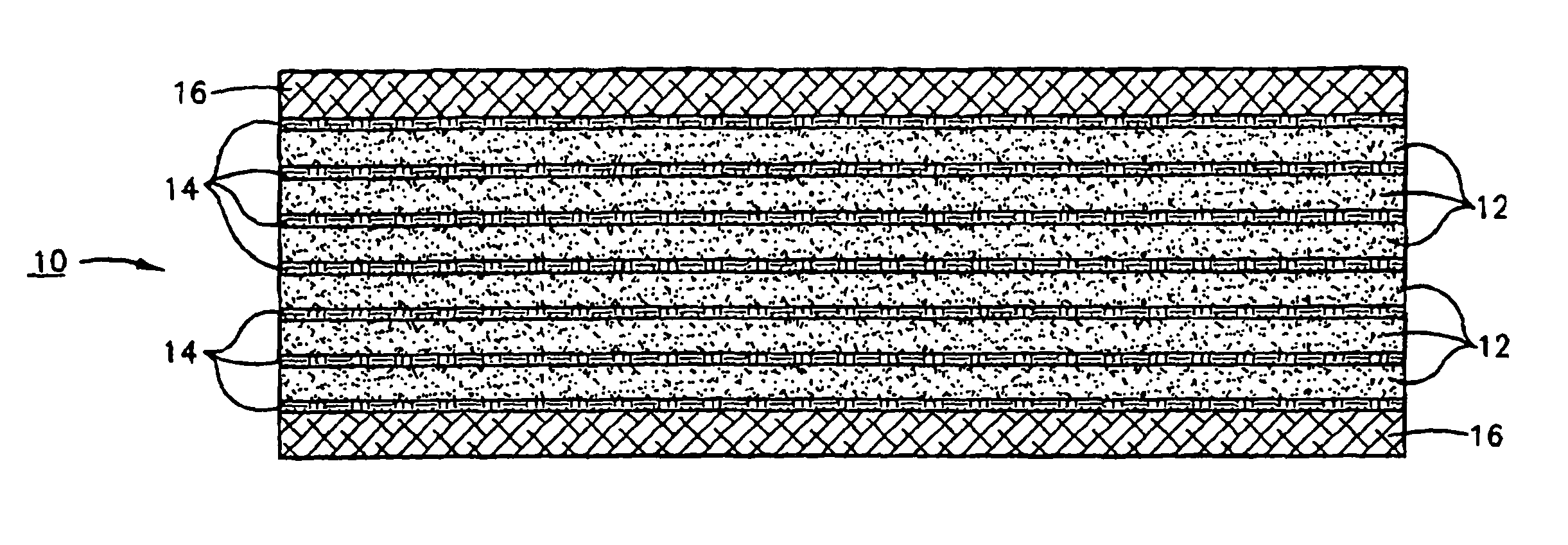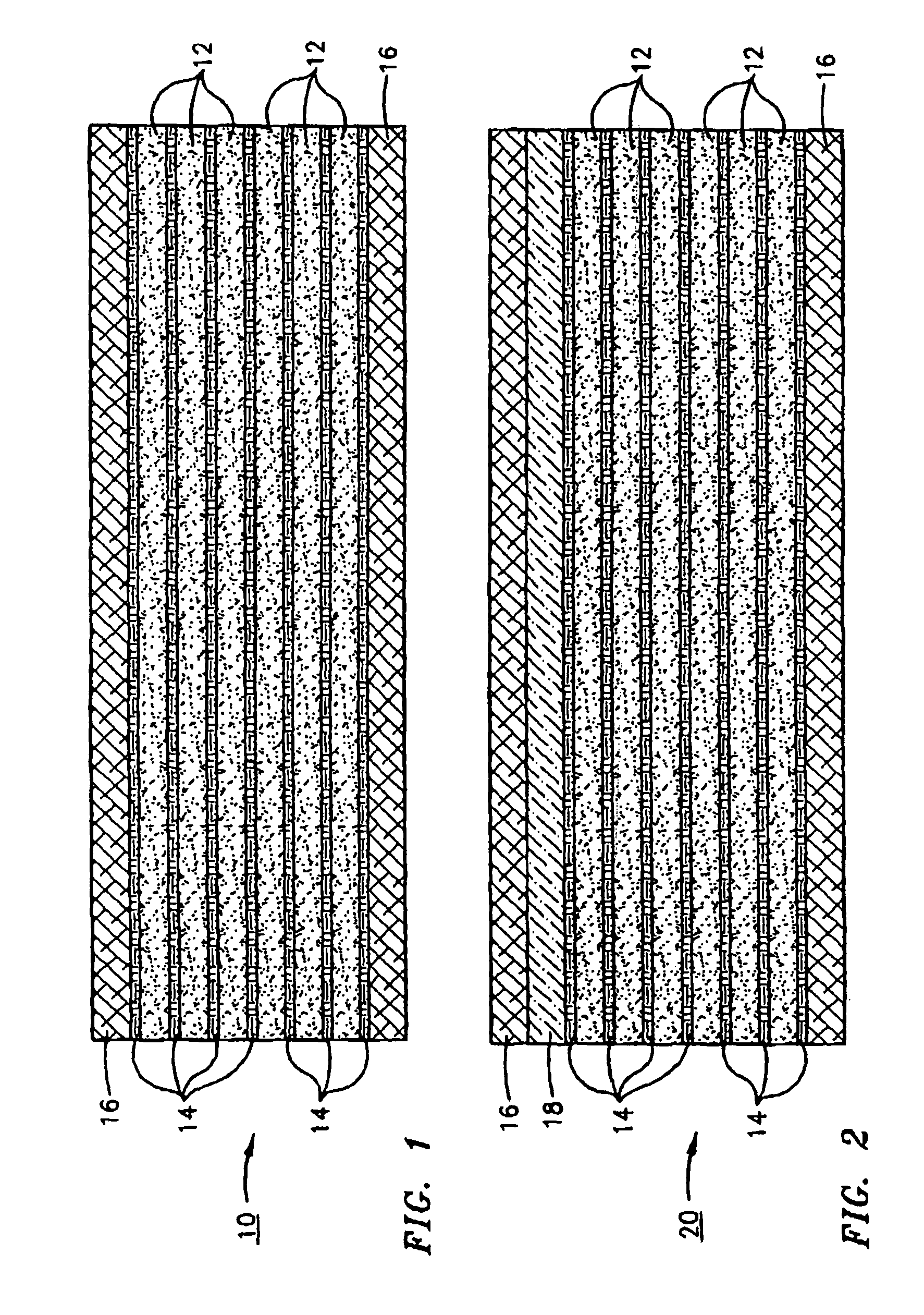Ballistic/impact resistant foamed composites and method for their manufacture
a composite material and foam technology, applied in the field of composite armor systems, can solve the problems of not having the required severe impact (ballistic) and flame resistance properties for many military applications, and their densities are generally too high for applications that require mobility, ground, sea or air, and achieve the effect of light weigh
- Summary
- Abstract
- Description
- Claims
- Application Information
AI Technical Summary
Benefits of technology
Problems solved by technology
Method used
Image
Examples
example 1
[0041]Xydar® SRT900 (LCP) powders were obtained from Amoco (4500 McGinnis Ferry Rd., Alpharetta, Ga. 30202). Kevlar® and Zylon® (PBO) fabrics were purchased from Barrday, Inc. (75 Moorefield St., P.O. Box 790, Cambridge, ON N1R 5W6) and Hexcel Schwebel (2200 South Murray Ave., Anderson, S.C.). Five pieces of PBO fabric about 12 by 12-in were cut. The Zylon®fabrics were laid in a steel mold and Xydar® powders spread between adjacent layers of Zylon® fabrics. The mold was then closed and heated up under clamping pressure to about 320° C. for about 30-min. After cooling to ambient a consolidated panel was obtained. The consolidated panel was foamed using a pressure vessel at a foaming temperature of about 370° C. under nitrogen gas at about 3000 psi in accordance with the practice of U.S. Pat. No. 6,232,354 which is incorporated herein by reference in its entirety. After holding the temperature for a short period of time the gas was vented quickly and the sample removed from the mold. ...
example 2
[0042]Ultem® (polyetherimide) powders obtained from GE Plastics (One Plastics Ave, Pittsfield, Mass. 01201) and graphite / fabrics obtained from BFG Industries, Inc. (90 Huger Street, Cheraw, S.C. 29520) were molded into composite panels, 12 by 12-in, using 5 to 19 layers of Kevlar® or Zylon® (PBO) fabrics with Ultem powders between adjacent layers of fabric by treatment at about 325° C. under elevated pressure. Additional panels also containing 4 layers of graphite fabric, 2 near the bottom surface and 2 near the upper surface were also molded. The composite panels were foamed using a pressure vessel at about 300˜325° C. with nitrogen as the foaming gas, at pressures between about 1500˜5000 psi. After holding at temperature for about 20 minutes, the gas was vented and a foamed composite panel obtained. The foamed composite panel was sawed into cubical shapes for compression testing. Cross-sectional views show that these foamed composites have a very uniform structure. The results of ...
example 3
[0043]Phenolic coated Kevlar® fabrics and phenolic coated Zylon® containing less than 20% by weight of phenolic were obtained from Barrday Inc. and, Hysol® EA 9696 film and paste adhesives were obtained from Loctite Aerospace (2850 Willow Pass Road, P.O. Box 312, Bay Point, Calif. 94565). Facesheets were fabricated using 24 plies of Kevlar® 745 bonded with the Hysol® adhesives. These facesheets weighed about 2.5-lb and were 0.44-in thick. Compression molded panels 12.25 by 12.25-in were fabricated with these facesheets in accordance with the process described in Example 2. The thickness and weight of these panels were about 0.32-in and 1.79 lb. Similar panels were also fabricated using 20-25-layer of Zylon® fabrics. A panel with 25 plies of phenolic coated Zylon® weighed about 1.18 LB and measured about 0.203-in thick. Two facesheets and a foamed core were bonded together using either 2 layers of film adhesive or some paste adhesive, EA9696, between each interface. They were then cu...
PUM
| Property | Measurement | Unit |
|---|---|---|
| Pore size | aaaaa | aaaaa |
| Temperature | aaaaa | aaaaa |
| Pressure | aaaaa | aaaaa |
Abstract
Description
Claims
Application Information
 Login to View More
Login to View More - R&D Engineer
- R&D Manager
- IP Professional
- Industry Leading Data Capabilities
- Powerful AI technology
- Patent DNA Extraction
Browse by: Latest US Patents, China's latest patents, Technical Efficacy Thesaurus, Application Domain, Technology Topic, Popular Technical Reports.
© 2024 PatSnap. All rights reserved.Legal|Privacy policy|Modern Slavery Act Transparency Statement|Sitemap|About US| Contact US: help@patsnap.com










